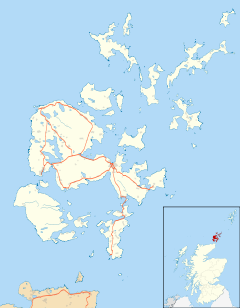
Holyrood Abbey is a ruined abbey of the Canons Regular in Edinburgh, Scotland. The abbey was founded in 1128 by David I of Scotland. During the 15th century, the abbey guesthouse was developed into a royal residence, and after the Scottish Reformation the Palace of Holyroodhouse was expanded further. The abbey church was used as a parish church until the 17th century, and has been ruined since the 18th century. The remaining walls of the abbey lie adjacent to the palace, at the eastern end of Edinburgh's Royal Mile. The site of the abbey is protected as a scheduled monument.

Kirkwall is the largest town in Orkney, an archipelago to the north of mainland Scotland.
William Sinclair (1410–1480), 1st Earl of Caithness (1455–1476), last Earl (Jarl) of Orkney, 2nd Lord Sinclair and 11th Baron of Roslin was a Norwegian and Scottish nobleman and the builder of Rosslyn Chapel, in Midlothian.

Birsay is a parish in the north west corner of The Mainland of Orkney, Scotland. Almost all the land in the parish is devoted to agriculture: chiefly grassland used to rear beef cattle. There are various ancient monuments in the parish.
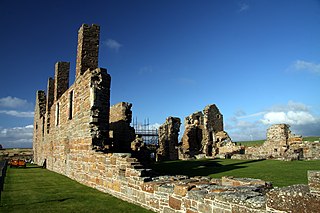
The Earl's Palace in Birsay, Orkney, Scotland, is a ruined 16th-century castle. It was built by Robert Stewart, 1st Earl of Orkney (1533–1593), illegitimate son of King James V and his mistress Euphemia Elphinstone. The palace is in the care of Historic Environment Scotland as a Scheduled Ancient Monument.

Scalloway Castle is a tower house in Scalloway, on the Shetland Mainland, the largest island in the Shetland Islands of Scotland. The tower was built in 1600 by Patrick Stewart, 2nd Earl of Orkney, during his brief period as de facto ruler of Shetland.

St Magnus Cathedral dominates the skyline of Kirkwall, the main town of Orkney, a group of islands off the north coast of mainland Scotland. It is the oldest cathedral in Scotland, and the most northerly cathedral in the United Kingdom, a fine example of Romanesque architecture built for the bishops of Orkney when the islands were ruled by the Norse Earls of Orkney. It is owned not by the church, but by the burgh of Kirkwall as a result of an act of King James III of Scotland following Orkney's annexation by the Scottish Crown in 1468. It has its own dungeon.
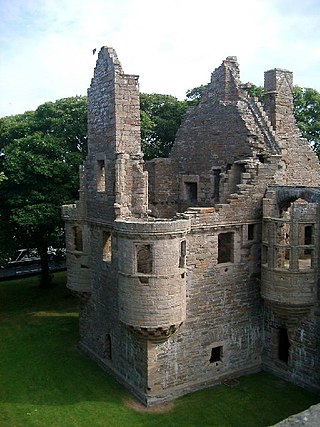
The Earl's Palace is a ruined Renaissance-style palace near St Magnus's Cathedral in the centre of Kirkwall, Orkney, Scotland. Built by Patrick, Earl of Orkney, its construction began in 1607 and was largely undertaken via forced labour. Today, the ruins are open to the public.

Muness Castle is located on Unst, which is one of the Shetland Islands of Scotland. The castle is 3 kilometres (1.9 mi) east of the village of Uyeasound. Unst is Scotland's most northerly inhabited island, and Muness is the most northerly fortalice in the British Isles. It was designated as a Scheduled monument in 1953 and is run as a museum by Historic Environment Scotland.

Robert Reid was Abbot of Kinloss, Commendator-prior of Beauly, and Bishop of Orkney. He was born at Aikenhead in Clackmannan parish, the son of John Reid and Elizabeth Schanwell. His formal education began in 1511 at St Salvator's College in St Andrews University under the supervision of his uncle, Robert Schanwell, dean of the faculty of arts. Reid graduated in 1515 and by 1524 was subdean at Elgin Cathedral where, by 1527, he was Official of Moray. Thomas Chrystall, the abbot of Kinloss, chose Reid as his successor in 1526. In 1527, as abbot-designate, he attended the court of Pope Clement VII on abbacy business. While returning via Paris in 1528, Reid met the Piedmontese humanist scholar Giovanni Ferrerio who accompanied him back to Scotland. Following Chrystall's resignation in July 1528, Reid was blessed as abbot in September and received the Priory of Beauly, in commendam, in 1531. In that same year, Ferrerio left the court of James V to join Reid at Kinloss as tutor to the monks of both Kinloss and Beauly. Reid held many offices of state between 1532 and 1542 including ambassadorial roles to England and France and as a senior law official. He considerably improved the external and internal fabric of both monasteries in 1538.

Patrick Stewart, 2nd Earl of Orkney, Lord of Zetland was a Scottish nobleman, the son of Robert, Earl of Orkney, a bastard son of King James V. Infamous for his godless nature and tyrannical rule over the Scottish archipelagos of Orkney and Shetland, he was executed for treason in 1615.

Spynie Palace, also known as Spynie Castle, was the fortified seat of the Bishops of Moray for about 500 years in Spynie, Moray, Scotland. The founding of the palace dates back to the late 12th century. It is situated about 500 m from the location of the first officially settled Cathedral Church of the Diocese of Moray, Holy Trinity Church in present-day Spynie Churchyard. For most of its occupied history, the castle was not described as a palace — this term first appeared in the Registry of Moray in a writ of 1524.

Braal Castle is located by the River Thurso north of the village of Halkirk, in Caithness, northern Scotland. The ruined castle, which dates back to the mid-14th century, was originally known as the Castle of Brathwell.

Clan Stewart (Gaelic: Stiùbhart) is a Scottish Highland and Lowland clan. The clan is recognised by Court of the Lord Lyon; however, it does not have a Clan Chief recognised by the Lord Lyon King of Arms. Because the clan has no chief it can be considered an armigerous clan; however, the Earls of Galloway are now considered to be the principal branch of this clan, and the crest and motto of The Earls of Galloway's arms are used in the Clan Stewart crest badge. The Court of the Lord Lyon recognises two other Stewart/Stuart clans, Clan Stuart of Bute and Clan Stewart of Appin. Clan Stuart of Bute is the only one of the three clans at present which has a recognised chief.

St Magnus's Church is a ruined medieval church located on the island of Egilsay, in Orkney, Scotland. The site is recognized as the place of execution of Saint Magnus Erlendsson, Earl of Orkney, in the 12th century. The roofless structure dates back to the 12th century, and has been described by Historic Environment Scotland (HES) as second only to St Magnus Cathedral, Kirkwall, as a surviving Norse church in Scotland.
Kirkwall Castle, also known as King's Castle, was located in Kirkwall, the main settlement in the Orkney Islands of Scotland. Built in the 14th century, it was deliberately destroyed in 1614. The last ruins were cleared in the 19th century. The castle was located around the corner of Broad Street and Castle Street in the centre of Kirkwall.
Sir John Clere was an English politician and naval commander.
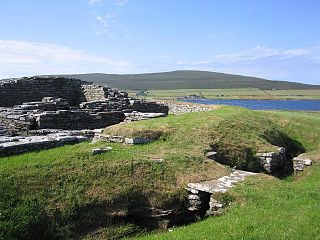
Cobbie Row'sCastle is the oldest medieval castle known to exist in Scotland. The castle ruins are located on the island of Wyre in Orkney. Built in the mid-12 century by Norse landowner, Kolbeinn hrúga, the stone fortification originally consisted of a small, central tower set in an oval enclosure, surrounded by two ditches, a stone wall and an earthen rampart. Historic Environment Scotland established the site as a scheduled monument in 1929.

Kirkwall Town Hall is a municipal building in Broad Street, Kirkwall, Orkney, Scotland. The structure, which is currently used as a community events venue, is a Category B listed building.
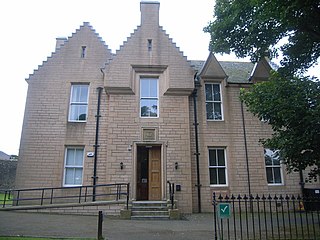
Kirkwall Sheriff Court is a judicial structure in Watergate, Kirkwall, Orkney, Scotland. The structure, which was the headquarters of Orkney County Council and is currently used as a courthouse, is a Category C listed building.

